Temperature measurements on the GPU diode
First, we measure tmeperature development in the GPU by completing three one-hour runs with different scenarios. First, the metro last light card has to cope in 4K resolution, then the whole thing again – but with the maximum possible clock of 2114 MHz (just under 2.1 GHz on average for the entire session). Unfortunately, our reference design couldn't do more despite maximum power target and adjusted voltage settings (curve). At the very end we let Furmark run for another hour.
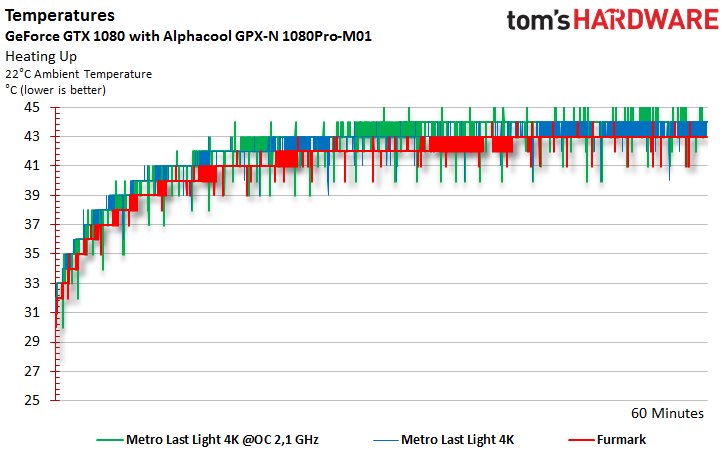
We can see from the curves that the temperatures inside the GPU were still well below and below 45°C even after one hour, which is a really good value. We will compare this to the MSI GeForce GTX 1080 Sea Hawk later. But first we want to measure a little more precisely what else gets warm – and above all, where and how.
Infrared measurements with the thermal camera
Unfortunately, the backplate obscures the board, so that a direct measurement seems impossible. However, the whole review would be richly pointless and worthless if one wanted to measure only from the outside and estimate something. Since this would be unprofessional on the one hand and on the other hand nobody really benefits, we simply started the drill with a heavy heart.
Since we know the resolution of our thermal imaging camera and the required distance to the map, it was also not difficult to determine the minimum borehole diameter for a safe evaluation, which we wanted to keep as small as possible in order to avoid influences.
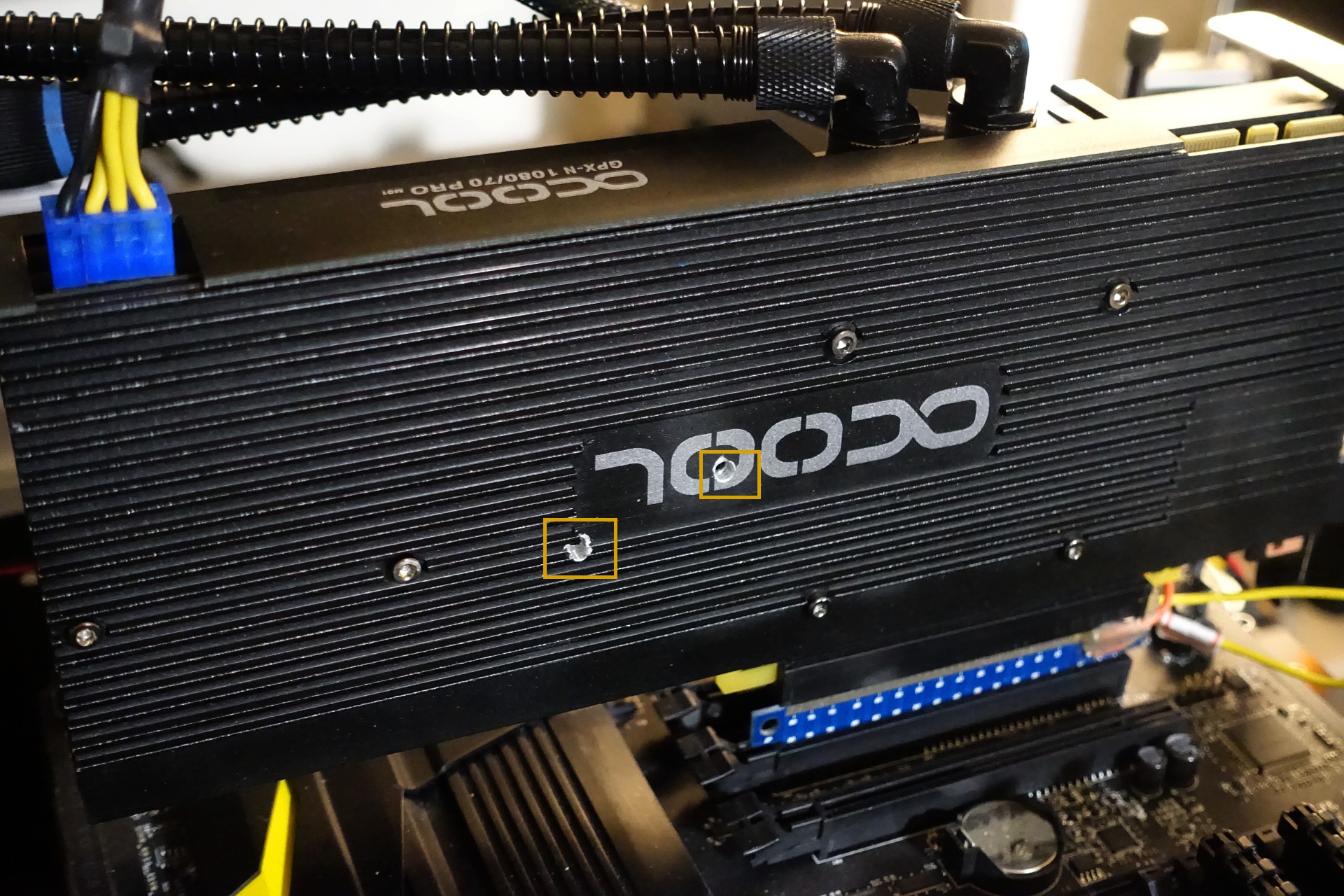
For this purpose, five millimeters of hole diameter are easy enough, so that we have drilled a hole at the hotspots next to the voltage converters and the hottest of the eight memory modules, which does not sit above a pad. In addition, we have seen the relevant areas with calibrated measuring varnish. We will also show that the temperatures of the cooler and the backplate differ and allow little inferences about life below the surface.
In addition, we naturally measure the water temperatures in the inlet and outlet as well as the radiator plate, pump and board top from the frontal view. In addition, we have placed a temperature sensor for control in the flow, which is used for the plausibility control of the tmepratures measured at the pump connections and displays 23.6 °C in idle mode after one hour, whereas in the room exactly 22°C prevail. The GPU reports a difference between chip and water of less than two Kelvin at 25 to 26°C in the idle, which is quite fine.

Normal operation with full game load
We measure at 44°C GPU temperature (diode) just under 73°C for the voltage converters and 70°C for the hottest memory module, while the backplate gets warm at the hottest point 60 °C and above the GPU just under 54°C. Conversely, this also means that the GPU cools the backplate with it and not the other way around. After one hour, the water temperatures are at just under 34 °C at the inflow and around 37 °C at the drain, which are actually very good values.
The front panel is still about 50 °C hot above the voltage converters, which also proves that the heat dissipation in the direction of the pump heat sink works quite well here. Nevertheless, it is not a "real" full-cover water cooler, in which the cooling circuit extends even over the voltage converters. One could at least insert a heapipe in order to be able to release even more heat to the water – because carefully estimated here at least 50 percent of the component waste heat from storage and voltage converters is delivered directly to the air and thus remain in the housing.
If you now add up the power consumption for the memory and the voltage transformer losses (approx. 50 to 60 watts), that would be up to 30 watts. Of course, this is not yet dramatic, but with an SLI setup we would be at about 60 watts of waste heat, which cannot be fed into the water, but will be exchanged against the air in the housing.
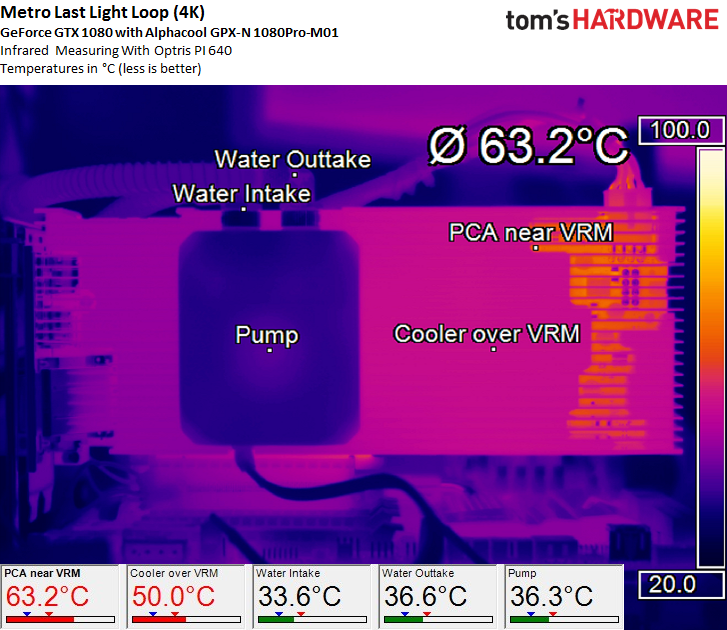 |
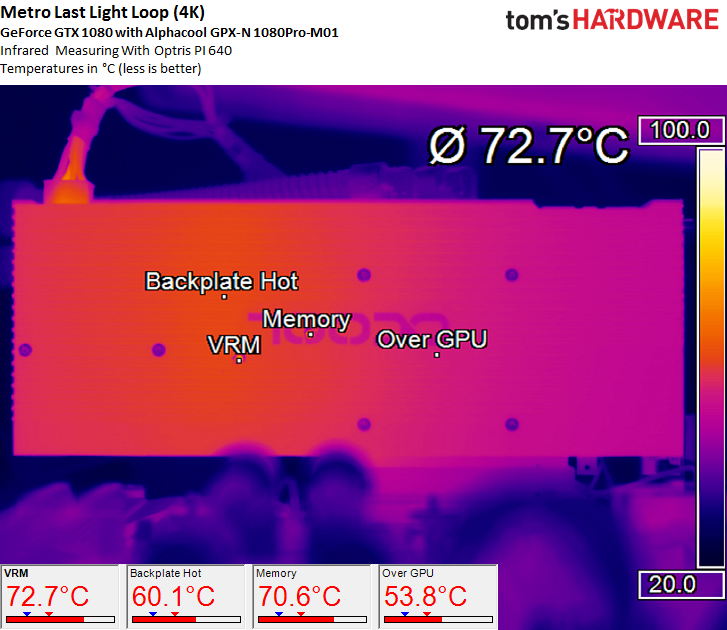 |
Overclocking up to 2.1 GHz
Our overclocking clearly shows that the Alphacool ice grinder water cooling has everything under control. After one hour, the voltage transformer tmeperatures are only two Kelvin above our reading without overclocking and the water heats up only minimally. Greed has much more potential in it; you would also get more performance-hungry GPUs loosely cool.
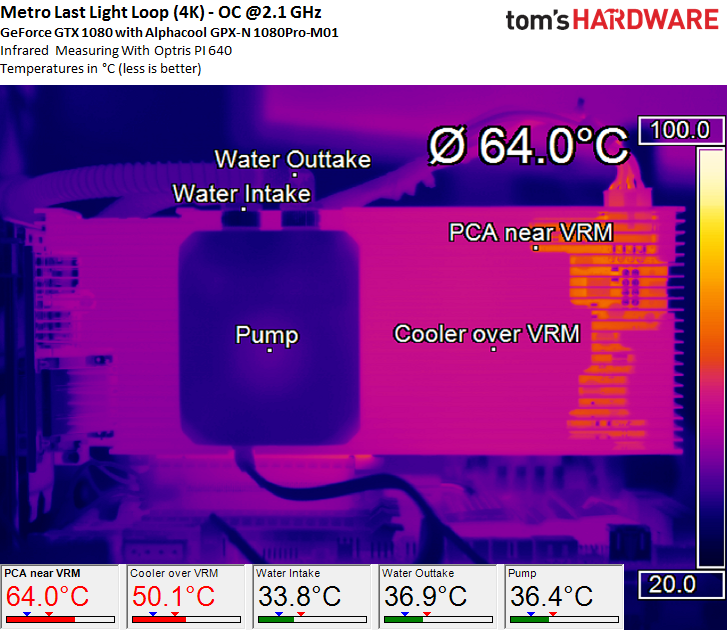 |
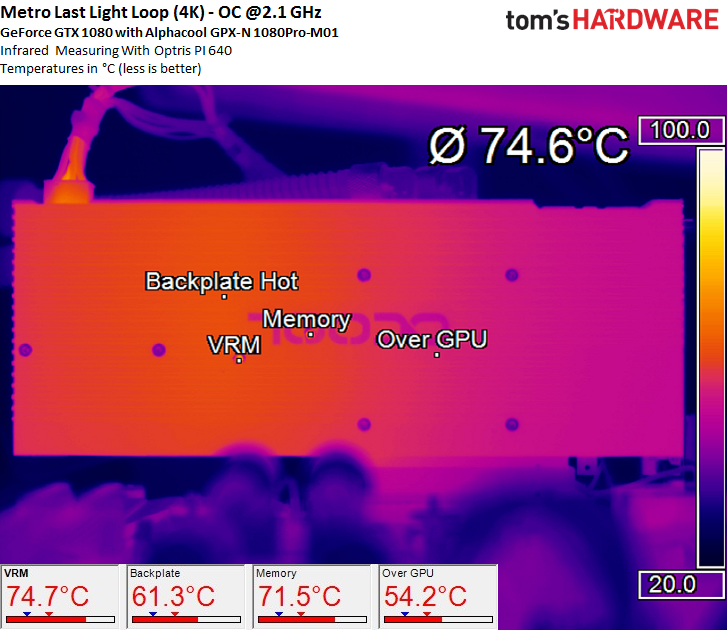 |
Stress test (Furmark)
Especially in the area of voltage converters, it is always the hottest – but this is nothing new with the Torture Loop. However, since the GPU is slowed down quite strongly by its Power Target and Boost, the water is even slightly cooler, because the cooling task shifts more towards air cooling through the heat sink and backplate. Despite the increased voltage transformer temperatures, one can also accept this measurement result, because even after two hours the whole thing does not get hotter.
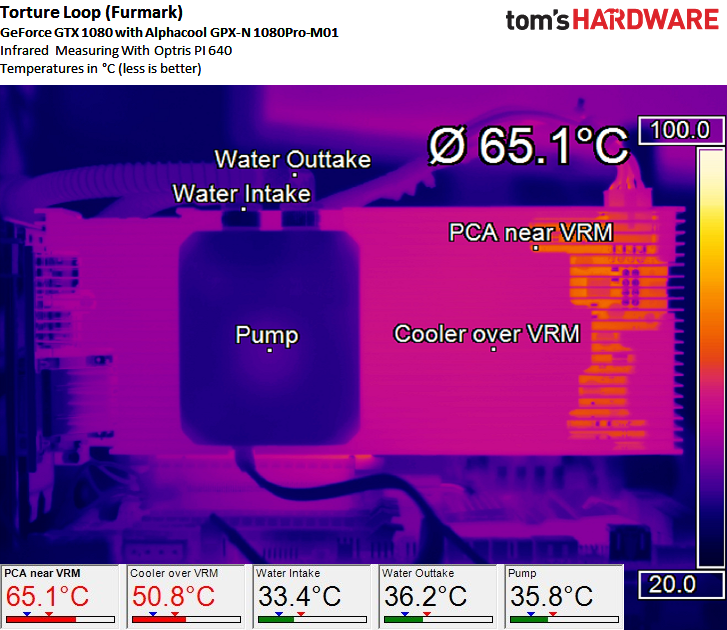 |
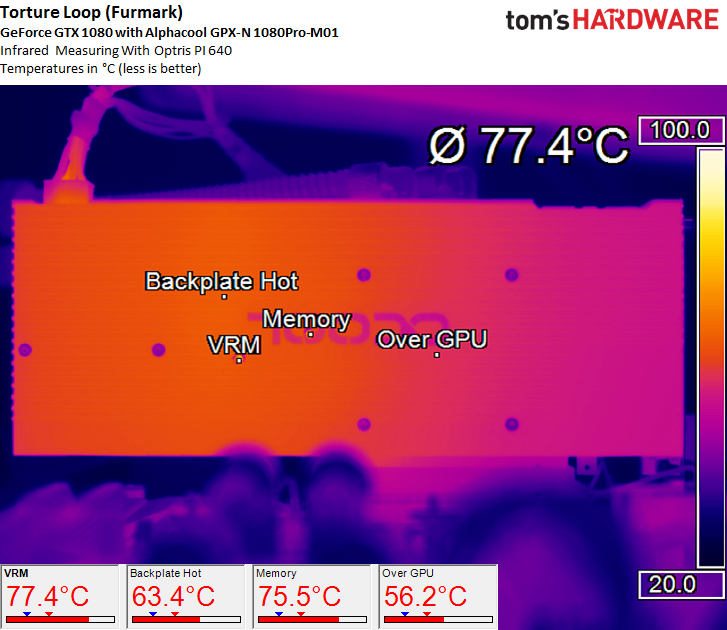 |
Comparison measurements for the MSI GeForce GTX 1080 Sea Hawk
Since they impose the measured values of the Sea Hawk with the same board for comparison, we have of course compared the two in conclusion. The measurement results clearly speak for the Alphacool ice wolf water cooling, not only because of the larger radiator. Even the GPU temperature has dropped significantly once again, because up to seven Kelvin are already very big worlds in the field of water cooling, if not half the cosmos.
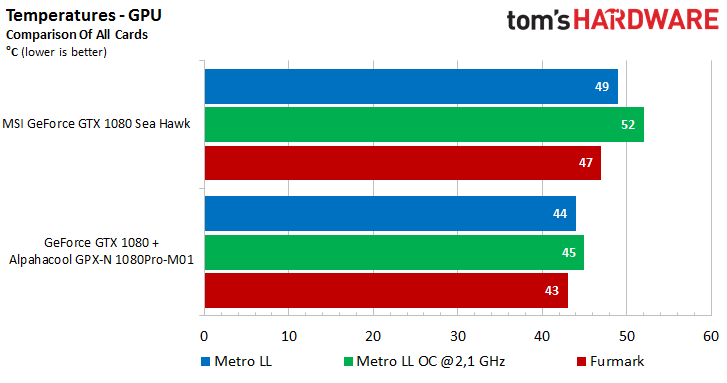
For the voltage converters we reach up to 12 Kelvin difference, which is due to a house number, but also due to the poor component cooling of the Corsair cooling on the Sea Hawk, whose cooling frame is blown with air, but completely incomprehensible has no cooling fins in the relevant locations.
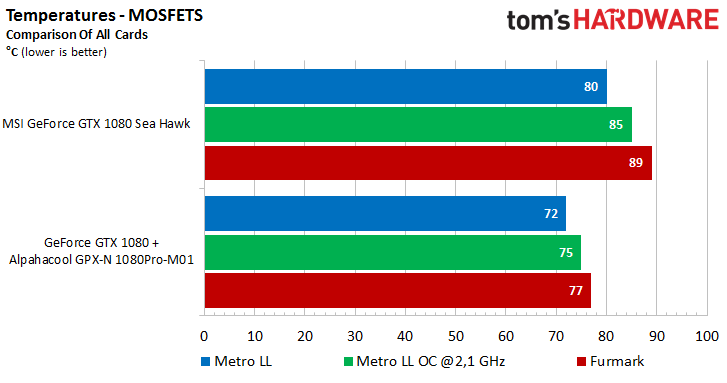
In the memory, there are then up to seven Kelvin difference, which can easily button off the ice wolf cooling of the cooling of the Sea Hawk.
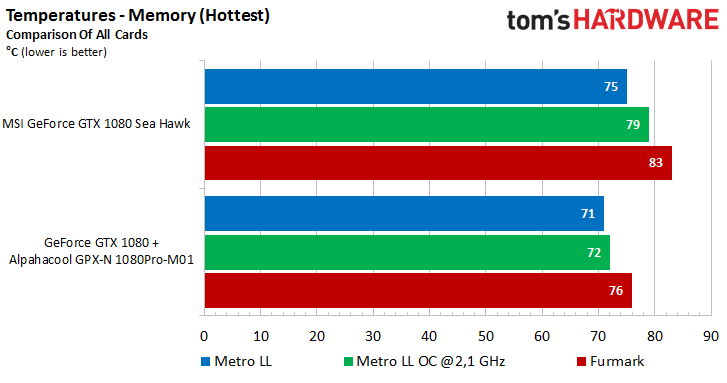
Water temperatures in comparison
Finally, if we look at the water temperatures, the dilemma of Corsair Hybrid solution quickly becomes clear to us. With up to 16 (!) Kelvin Difference, the smaller cooling circuit suffers from "blood poverty": Too little water and too much air in the radiator as an unused compensating tank ensure that the GPU gets significantly warmer, even if the water cooling does not even match the waste heat of the components must be disbled.
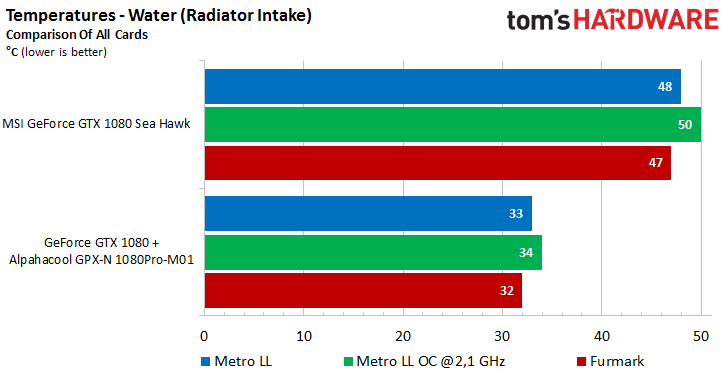
We see once again that the cooling of the GPU alone is only half and hard truth, which simply passes by life. If water, then right and not just half.
The Alphacool ice grinder also has the flaw in the fact that no water flows over the voltage converters and the waste heat must first go on a hike to the pump cooler. Here, at least, a heatpipe as a self-left companion wouldn't be a bad idea. Please think about it, dear manufacturer, even if you may have to throw some principles at the waste heap!
































Kommentieren